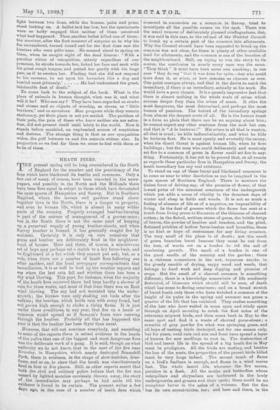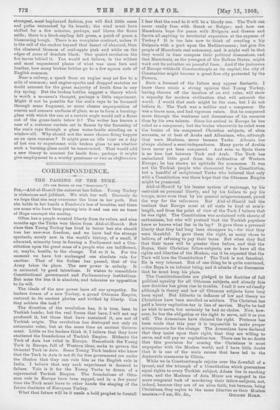HEATH FIRES.
THE present spring will be long remembered in the South of Englund for the number and the persistency of the fires which have blackened its heaths and commons. Only a few out of many, of course, have been reported in the news- papers, and possibly in the North and the Midlands there have been fires equal in extent to those which have devastated the open spaces of Hampshire and Surrey. But in Southern England, where the houses and gardens stead closer together than in the North, there is a danger to property, and even to human life, which is absent in many wilder parts of the country. Properly arranged heather-burning is, pert of the science of management of a grouse-moor; but in the South there is not the same need of keeping up a perpetual supply of young heather-shoots, and when Snrrey heather is burned, it has generally caught fire by accident. Certainly it is only on .rare occasions that gorse and heather are deliberately fired in the neighbour- heed of. houses, Here and there, of course, a relecbieyoes set of boys pally perhaps set a match to a dry furze-bush, and be frightened at a. fire which they cannot put out; but, as a rule, when there are e number of heath fires following one after another, and the local newspaper correspondents hint incendiarism, it is as well to look up the weather reports and pep when the last ,rain fell and whether there has been dry wind blowing. This year, for instance, when the majority of the heath fires occurred there had been hardly a shower of rein for three weeks, and most of that time there was an East wind blowing. The sap bad not mounted into the under- growth; the birches were only shaking out buds after the catkins; the bracken, which holds rain with every frond, had not grown high enough to choke a rising flame. It is just under those .couditiens, in any year, that fire on a heath or common would spread as if ,Samson's foxes were running through the heather. Probably ell th.t has happened this Year is that the heather has been dryer than usual.
However, that will not convince everybody, and according to some of the reports there is actual evidence in the bands of the police that one of the biggest and most dangerous fires was the deliberate work of a gang. It is said, though on what authority we do net know, that in the case of the fire near Evereley, in Hampshire, which nearly destroyed Bramshill Park, there is evidence, in the shape of slow-matches, time- fuses, and so on, to abgw that the heath wee simultaneously firecl, in four or five places. Still, as other reports assert that both the civil and military police believe that the fire was canoed by lighted matches carelessly thrown away, the story of the Incendiaries may perhaps be laid aside till the evidence ie found to be certain. The present writer a few days ago, in the ,case of a number a heath Ares which occurred in succession ou a common in Surrey, tried to investigate all the possible causes on the spot. There was
the usual rumour of deliberately planned conflagrations, due, it was said In this case, to the refusal of the District Council to break up a certain part of the common into allotments.
Why the Council should have been requested to break up the common was not clear, for there is plenty of other available laud for allotments, and the common is one of the beauties of the neighbourhood. Still, on trying to run the story to its source, the conclusion in nearly every case was the same.
"They think" it must have been some one smoking; in one ease "they do say" that it was done for spite,—but who could have done it, or when, or how remains as obscure as ever.
One point emerges always, and that is the desire to catch the incendiary, if there ie incendiary, actually at his work. He would have a poor chance. It is a queerly impressive fact that there is almost nothing in the whole scale of crime which
arouses deeper fury than the crime of arson. It stirs the most dangerous, the most determined, and perhaps the most human of passions., The hatred of the incendiary springs from almost the deepest roots of all. He is the human beast in a form so plain that there cnu be no arguing . about him I
he cannot expect any other sentence from the mob but one,
and that is "A la lanterns !" His crime is all that is wanton, all that is cruel; he kills indiscriminately, and what he kills
lie tortures first. He is most openly and avowedly the enemy, when his direct threat is against human life, when he fires buildings ; but the man who could deliberately and wantonly set fire to a common of gorse in flower could set fire to any- thing. Fortunately, it has yet to be proved that, at all events as regards these particular fires in Hampshire and Surrey, the heath incendiary has any real existence.
To stand on one of these burnt and blackened commons is to come as near to utter desolation as can be imagined in the
open spaces of Southern England. There is nowhere the tiniest force of driving sap, of the promise of 'flower, of that lowest pulse of the minutest creatures of the undergrowth which yet adds a sense of vitality to the dreariest days of
winter and sleep in fields and woods. It is not so much a feeling of absence of life as of a negation, an impossibility of living. In the dust of grasses which the flame has sent at a touch from living green to filaments of the thinness of charred cotton; in the flaked, writhen stems of gorse, the brittle twigs
of broom, the powder of heather and bracken, and the piled, flattened prickles of hollow furze-bushes and brambles, there ie no hint or hope of sustenance for any living creature.
The very smell of the place is of death ; not the smell of green branches burnt because they must be cut from the tree, of weeds set on a bonfire to rid the soil of cumbering growth. The smell of a bonfire is one of the good smells of the country and the garden ; there is a richness somewhere in the wet, vaporous smoke, in the greedy crackle of drying, sappy wood and weeds, that belongs to hard work and deep digging and promise of crops. But the smell of a charred common is something
different; there is a knowledge somewhere of life needlessly destroyed, of blossoms which should still be seen, of death which has come to fleeing creatures; and on a broad stretch of burnt heath only those who have watched a common at the height of its pulse in the spring and summer can guess a quarter of the life that has vanished. They realise something
of the loss who have waited in some open and windy space through an April morning to catch the first notes of the returning migrant birds, and then come back in May to the same spot and find it a waste of charred gorse-stems ; a crumble of grey powder for what was springing grass, and all hope of nesting birds destroyed, not for one season only, but for years, until rain and sun and frost have spread a layer of humus for new seedlings to root in. The destruction of bird and insect life in the spread of a big heath fire in May must be prodigious. All the birds are nesting, and besides the lees of the nests, the proportion of the parent birds killed must be very large indeed. The merest touch of flame on a bird's feathers is enough, and flame in a wind moves fast. The whole insect life, wherever the fire moves, perishes in a flash. All the moths and butterflies whose caterpillars and chrysalises are harboured in the lowly undergrowths end grasses end their cycle; there could be no completer havoc in the ashes of a volcano. But the fire has its own eecentricitlee, too ; and here and there, in the strangest, most haphazard fashion, you will find little oases and paths untouched by its breath; the wind must have shifted for a few minutes, perhaps, and blown the flame aside ; there is a birch-sapling left green, a patch of grass, a blossoming bough. There is no completer contrast, unless it is the call of the cuckoo beyond that desert of charcoal, than the clustered blossom of crab-apple pink and white on the edges of acres of desolate black. One quaint revelation the fire leaves behind it. You would not believe, in the wildest and most sequestered places of what was once fern and heather, bow many broken bottles go to a few square rods of English common.
Near a railway, a spark from an engine may set fire to a mile of common; and engine-sparks and dropped matches no doubt account for the great majority of heath fires in any dry spring. But the broken bottles suggest a theory which is worth a moment's thought, perhaps a little experiment. Might it not be possible for the sun's rays to be focussed through some fragment, or some chance superposition of convex and concave surfaces of glass, so as to form a burning- glass with which the sun at a certain angle would call a flame out of the grass-bents below it? The writer has known a case of a cretonne curtain set in flames by the focussing of the sun's rays through a glass water-bottle standing on a window-sill. Why should not the same chance firing happen on an open common P It might pass an idle hour on a day of hot sun to experiment with broken glass to see whether such a burning-glass could be constructed. That would add a new theory to account for heath fires ; perhaps it might give employment to a worthy pensioner or two as chifonniers.











































 Previous page
Previous page